
M.K. Gandhi. L’autogovern de l’Índia. Barcelona: Institut Català Internacional per la Pau; Angle Editorial, 2015. Col·lecció Clàssics de la pau i de la noviolència, 11.
In November 1909, Gandhi travelled back to South Africa by boat, after an infructuous diplomatic mission to London to defend the rights of the Indian minority in the African country. During the trip, he wrote fervently – changing to his left hand when the right one was exhausted- all his ideas on how India had to recover its political and cultural identity, and to overcome the influence of western civilization and get rid of British Colonialism.
The result of that is India’s Home Rule (Hind Swaraj), a book in which Gandhi exposes his own political program to transform India, based on the pursuit of individual and national independence and self-government, from a nonviolent perspective. Profoundly inspired in the pacifist ideas of Lev Tolstoi, the book gained popularity along with the growing influence of Gandhi himself, related to political life and the independence process of the country.
The author
Universal referent of nonviolence and one of the most influential political and spiritual leaders of the 20th C, Gandhi was born in 1869 in Porbandar, India. While he practiced as a lawyer in South Africa, he was severely discriminated for being Indian, which sharpened his social consciousness and fostered him to leader social movements against unfair laws.
After coming back to India in 1915, he fought against the caste system, against political and religious discriminations, and against the British metropolis. His arms were always pacific: boycott to foreign products, hunger strikes, marches, passive resistance and civil disobedience. He was murdered by a religious fanatic in 1948.
